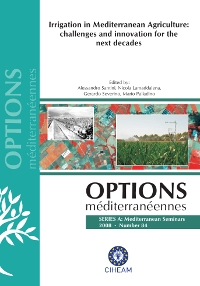| Article précédent | p. 115-123 | Article suivant |
Field examination of the hydrological behaviour of a typical vertisol in a cropped area
The site was selected in a cropped area on a typical vertisol, fairly uniform in depth, down to about 2.5 m. It was difficult to install anchored rods and piezometers at different depths (0.2-0.3-0.4-0.5-1-1.5-2 m and 2.5 m for piezometers). Soil moisture was monitored for a certain time by drilling the ground and soil samples were dried in an oven. Cases studied were: (A) a period of dry months with severe drought (10.4 mm in 132 days);(B) a second period with exceptionally uniform precipitation (about 3.5 mm/day during 2 months). These seasonal conditions permitted the following observations: for (A) the swelling of the soil in the lower extreme cannot be strictly compared to Philip's (1969) concept of a free expansion of the water ponding on soil due to the overburdening of different conditions; for (B) the expected tendency to begin a stationary water flux depends strongly on the water regime in the previous period. In a dry period, the water accumulates in the deepest piezometers, being fed by water from the upper source at a progressively increasing rate of water rise. The regime of stable water flux is therefore delayed. The hydraulic conductivity changes in different soil layers according to the water content.
Les sols gonflables sont caractérisés par des phénomènes de distribution des efforts entre la phase solide et liquide. L'ouvrage aborde plus particulièrement les difficultés de l'implantation verticale des tiges de métal et des piézomètres à différentes profondeurs (0,2-0,3-0,4-0,5-1-1,5-2 m pour les tiges de métal et 2,5 m pour les piézomètres) dans un vertisol. L'humidité a été quantifiée pendant deux ans en perforant le terrain et la mesure directe de la teneur en eau des échantillons a été faite par séchage. On a examiné deux situations météorologiques différentes : (A) une saison caractérisée par une période sèche (10,4 mm de pluie en 132 jours) et (B) une saison humide avec une pluviosité exceptionnellement uniforme (3,5 mm de pluie par jour pendant deux mois). Ces conditions climatiques ont permis les observations suivantes : dans la phase sèche (A) le gonflement des argiles est nettement différent par rapport au schéma de libre expansion proposé par Philip (1969), à cause de la présence d'une nappe phréatique d'environ 2.5 m de profondeur ; dans la phase humide (B) le flux des eaux n'est pas stationnaire et dépend avant tout du régime hydraulique au début de la période des pluies. Dans ce contexte, en période sèche, l'eau s'accumule dans les piézomètres les plus profonds, alimentés par l'eau dérivant de la source supérieure à un taux croissant de remontée. Ce phénomène se produit lentement initialement et s'accélère avec l'infiltration de l'eau. La conductivité hydraulique change dans les différentes couches du sol en fonction de leur humidité.
- [ Afficher ]
- [ Télécharger ]
- [ Exporter la citation ]
Vous pouvez télécharger la citation au format :
- [ Imprimer ]
-
Mots-clés
PIEZOMETRE, SOL ARGILEUX, VERTISOLCiter cet article
Cavazza L., Guarnieri A., Patruno A., Cirillo E., Lorenzini G., Piana S. Field examination of the hydrological behaviour of a typical vertisol in a cropped area. In : Santini A. (ed.), Lamaddalena N. (ed.), Severino G. (ed.), Palladino M. (ed.). Irrigation in Mediterranean agriculture: challenges and innovation for the next decades. Bari : CIHEAM, 2008. p. 115-123. (Options Méditerranéennes : Série A. Séminaires Méditerranéens; n. 84). International Conference on Irrigation in Mediterranean Agriculture: Challenges and Innovation for the Next Decades, 2008/06/17-18, Naples (Italy). http://om.ciheam.org/om/pdf/a84/00800957.pdf



